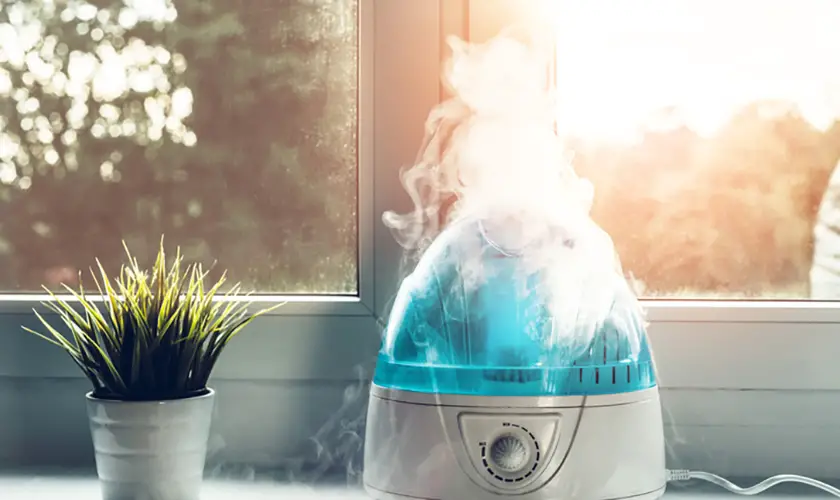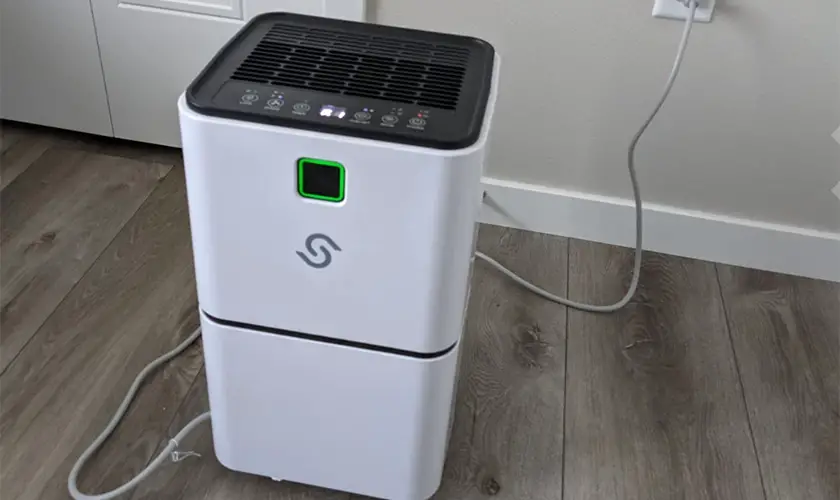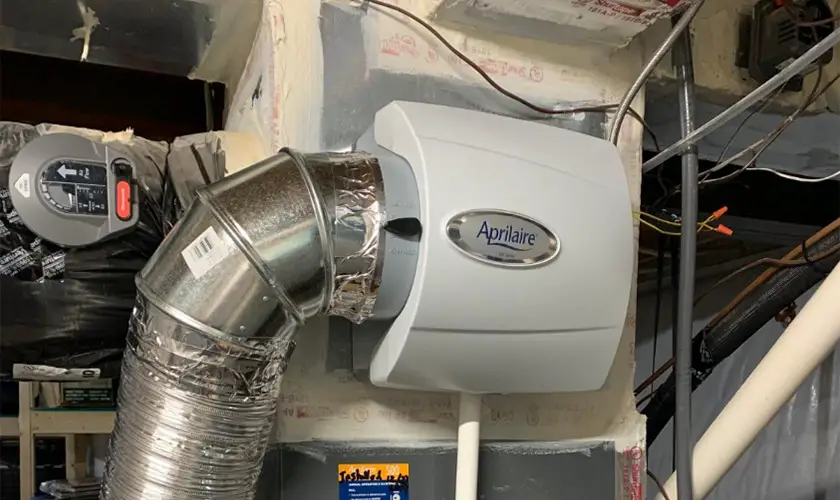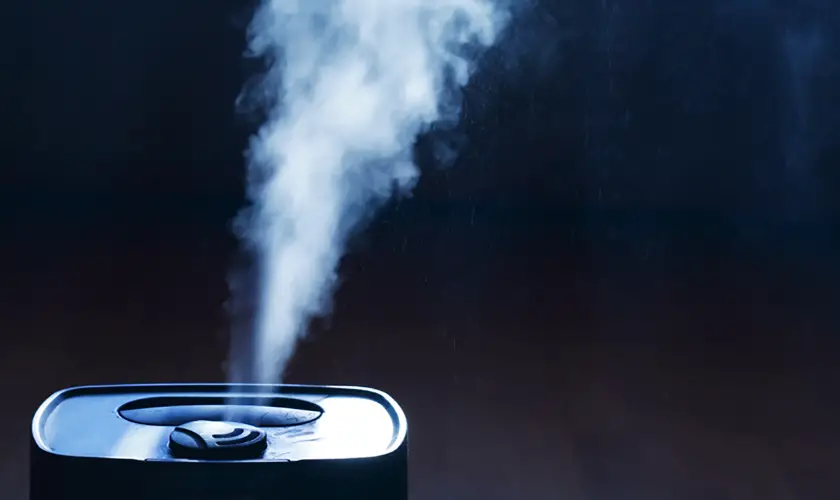
There are many factors to consider when choosing a humidifier or a dehumidifier. You might not think about the dryness or wetness of your air until it is too high or low.
If your skin is dry, cracking, or bleeding, this might be because of the dryness in the air. And if you just stepped out of the shower but can’t shake off all the water, then there is probably a lot of humidity in your house.
The air’s moisture amount is called relative humidity (RH). The most comfortable RH level is between 30-50%. It’s worth noting that anything more than 50% can cause bacteria to grow.
Typically, our environment does most of the work for us. But in extreme situations with dry or humid air, it can give us symptoms like hacking and coughing, shortness of breath, and tiredness. It can also worsen allergies and asthma by drying out your airways.
Here are two viable solutions to your issues with air that’s too dry or humid:
- Humidifier: works by adding extra moisture to the air.
- Dehumidifier: works by removing excess water vapor from the air.
Now that we know how these two devices work, we can talk about how they can improve your health when you use them indoors. We will compare and contrast the benefits of using these devices to those of using an air purifier.
Depending on the season and how dry or humid it is, you may need to use a humidifier or dehumidifier to maintain optimal humidity levels in your home. But what’s the difference, and which is right for you?
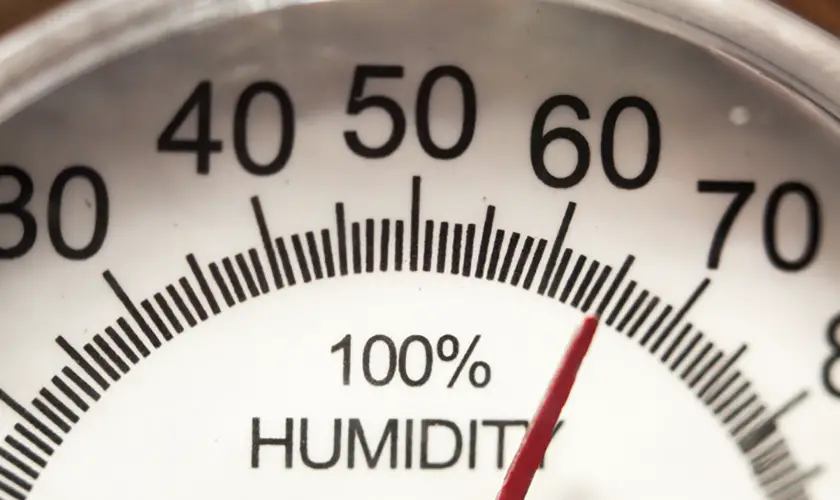
Humidifier vs Dehumidifier: How They Differ
Humidifiers increase the moisture in the air when it is too dry. In the winter, people use humidifiers to counter the aridity of winter air. When humidity levels are high, a dehumidifier removes moisture from the air. You can control seasonal allergies using a dehumidifier, as can dampness and mustiness that may accumulate in a home when there is high humidity.
Humidifiers are machines that add moisture to the air. They are used in the winter to add moisture to the air because it is dry. Dehumidifiers remove moisture from the air. They are used in the summer months when it is too humid outside.
Multiple studies have revealed that the ideal humidity level for most homes falls between 40 and 60 percent. Maintaining these humidity levels in your home could reduce health problems related to high or low humidity levels.
A hygrometer is necessary to take the correct humidity measurements of your house. However, because levels tend to differ based on seasons, you’ll have to readjust them now and then for optimum comfortability in your home.
How Humidifiers Work
Humidifiers add moisture to the air to raise the humidity level in an indoor environment.
There are two types of humidifiers: portable humidifiers and whole house humidifiers.
Most whole house humidifiers are warm-mist humidifiers, also called steam humidifiers, that work with your home’s HVAC system.
Portable humidifiers can be cool or warm humidifiers, depending on the humidifier’s purpose.
Although the air’s moisture is more or less equal, other factors should be considered when choosing a humidifier. For example, some types of cool-mist humidifiers work by:
- The impeller is a ceramic or metal plate that vibrates at extremely high speeds to agitate water into tiny droplets, released through an aperture and dispersed into the air.
- Ultrasonic humidifiers use vibrations to make tiny water droplets in the form of steam, which are released into the air through a cooling coil.
- Evaporative humidifiers moisturize the air by blowing cool air over a moist item, such as a belt or filter.
A cool mist humidifier disperses tiny water droplets into the air. These droplets turn into water vapor, which helps to cool the air.
How portable humidifiers work in general:
- The humidifier needs electricity to work. You can plug it into a standard electrical outlet to do this.
- The electricity generates heat in a container filled with water until it boils.
- The boiling water creates steam, which is then cooled. The humidifier has an opening or a tube to breathe in the water vapor.
- They are easy to set up and use.
- They require routine cleaning for optimal performance.
- Steam vaporizers can be used with inhalants or essential oils to help people with allergies or asthma.
How whole house central humidifiers work in general:
- The humidifier connects to the air return or heat supply ductwork
- The humidifier uses water to create vapor when heat flows across a wet pad.
- The hot air picks up moisture and distributes it back into the house.
- Some whole-house dehumidifiers have a powered fan (see below) to operate when the heat is not in use.
- Requires professional installation and semi-annual to annual service.
How Dehumidifiers Work
Dehumidifiers remove moisture from the air and help to keep your house’s air drier. A regular dehumidifier may make it easier for you to breathe by lowering the RH (relative humidity) in your indoor air by 30 to 50 percent.
Here’s how a typical dehumidifier works:
- The dehumidifier has a fan that pulls in warm air and blows it over metal coils. The refrigerant cools the coils to lower the temperature.
- Warming the air causes it to shrink. Hot items are bigger than chilly ones, and as the air cools, tiny water droplets fall.
- Water droplets leave the warm air as they turn into condensation.
- The air conditioning removes moisture from the air and circulates it back into your home through a fan-powered tube.
Dehumidifiers remove surplus moisture from the air, which is helpful if you live in a humid climate or have had recent flooding inside your home.
Very moist environments can cause mold and dust mites, leading to allergic reactions and asthma attacks. Conversely, hot, dry air can lead to airway constriction due to how our nerves respond to it.
Use a dehumidifier when:
- You suffer from chronic or seasonal allergies
- If your home smells damp or, some areas seem excessively moist
- Your home feels humid, and you can see water vapor in the air
- Your windows condensate during the morning
- You have an allergy to dust mites
- If you have pests such as spiders or silverfish in your home
- Fungi are developing on wood furnishings or surfaces in your house.
- When you line-dry your clothes, they take a long time to dry
- If you find yourself frequently having coughing fits or runny noses
Portable dehumidifiers help control moisture in small and large rooms. Their portable design allows you to put it away when not in use.
Permanent commercial-grade dehumidifiers work year-round to maintain optimal humidity levels in harsh environments. These can include:
- Whole house dehumidifiers connect to your ductwork and work with your home’s HVAC system.
- Basement dehumidifiers specifically work to control humidity in finished and unfinished basements.
- Crawl space dehumidifiers work to control moisture in damp crawl spaces, which can cause mold growth and wood rot.
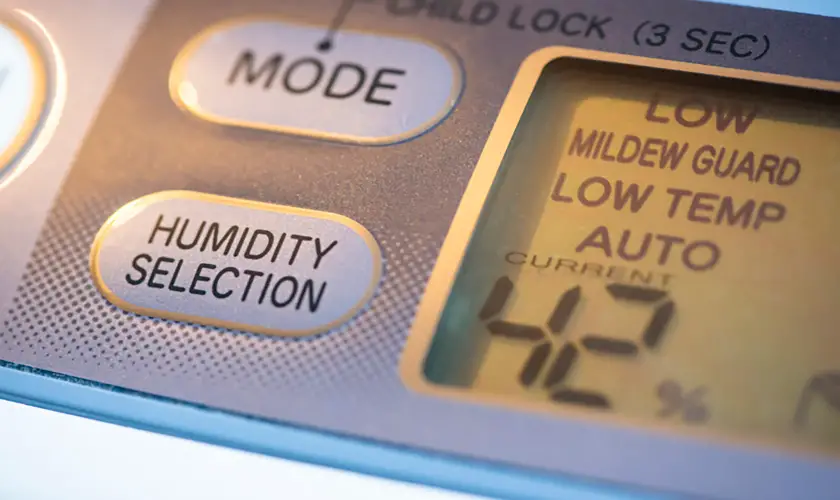
Humidifier vs Dehumidifier: Which to Buy
Most homes have a humidity level between 30% and 50%. However, if the humidity in your home is above 50%, you will need to purchase a dehumidifier. On the other hand, if levels are below 30%, then you will require a humidifier.
When to Choose a Humidifier
Humidifiers, as previously said, generally add moisture to the air. As a result, if the humidity levels in your house are below 30%, you should purchase a humidifier. When the air inside your home is excessively dry, particularly during the winter months, it can absorb moisture from your body. Your skin, including lips, eyes, and hair, becomes dry and itchy.
In addition to making you more likely to get nosebleeds and respiratory illnesses, dry air can damage your furniture. If you notice any of these problems in your home, it’s time to buy a humidifier.
A humidifier helps to keep your skin hydrated, improve your scratchy and sore throat, and minimize coughing, nosebleeds, and headaches. It will also moisten your nasal passages. Before purchasing a humidifier for your home, it’s essential to understand that they come in the following different types:
Bypass Humidifier
HVAC humidifiers are often directly linked to the system. They combine water with the heated air from the heat ducts, adding moisture to the space. These humidifiers are usually straightforward, inexpensive, and effective in correcting most low-humidity issues.
Powered Humidifier
A powered humidifier is similar to a bypass humidifier. The only distinguishing powered humidifiers from bypass humidifiers is that they contain powered fans that produce humidity even when the HVAC system isn’t operating.
Steam Humidifier
The other humidifiers rely on your HVAC system to generate moist air, while steam humidifiers have self-contained heating elements that create moisture. Therefore, steam humidifiers are more flexible and can work without depending on your HVAC system.
When to Choose a Dehumidifier
If the humidity in your home is over 60%, we strongly urge you to buy a dehumidifier. The reason is that too much moisture in the air will make anyone uncomfortable and make it more challenging for our bodies to lower our temperature naturally.
High humidity levels make it conducive to germination and dust mites. It’s also worth noting that excessive dampness poses a significant risk to your property. It might lead to decay and damage to your furniture and provide a breeding ground for fungi and other pests like termites.
If you install a dehumidifier, you’ll keep your home’s humidity levels in check, especially if the air conditioner isn’t doing the trick. There are two primary methods of installing a dehumidifier in your house. Depending on your preference and requirements, you may add them to your HVAC system or set them up as stand-alone units.
Believe it or not, some dehumidifiers can double as ventilators, providing fresher indoor air quality. Other benefits of using a dehumidifier include getting rid of pesky allergies, reducing any moldy smells in your home caused by wet areas, and making sure said wet area dries out before mold has a chance to grow.
When shopping for the perfect humidifier for your home, keep an eye out for these types:
Heat Pump Dehumidifier
Most dehumidifiers on the market depend on heat pumps, coils, and fans to reduce moisture in the air. The device uses a fan to suck in air blown over extremely cold exchange coils. This process causes water vapor to condense and be collected.
Ventilating Dehumidifier
Exhaust fans are used in these dehumidifiers to remove humid air from the space. Crawlspaces, basements, and attics are the most common applications.
Desiccant Dehumidifier
Desiccant dehumidifiers remove excess moisture from the air using hydrophilic materials like silica gel. They’re perfect for areas with low temperatures and high humidity levels.
Should You Use a Humidifier and Dehumidifier Together
Do you want to install a humidifier and dehumidifier in your home? You might think this is a good idea, but it’s not recommended. The sole purpose of humidifiers and dehumidifiers is to either add or remove moisture from the air inside your home.
We suggest you buy one (but not both) based on your prevalent climate or indoor conditions.
- If you live in a mostly humid area, buy a dehumidifier with a programmable humidistat.
- If you live in a drier area, buy a humidifier with a programmable humidistat.
You can buy a programmable humidifier or dehumidifier to ensure your home is in the perfect humidity. This device will help keep the humidity in your home at the level you choose. If you want to reduce the humidity, turn off the machine and let outside air do its job.
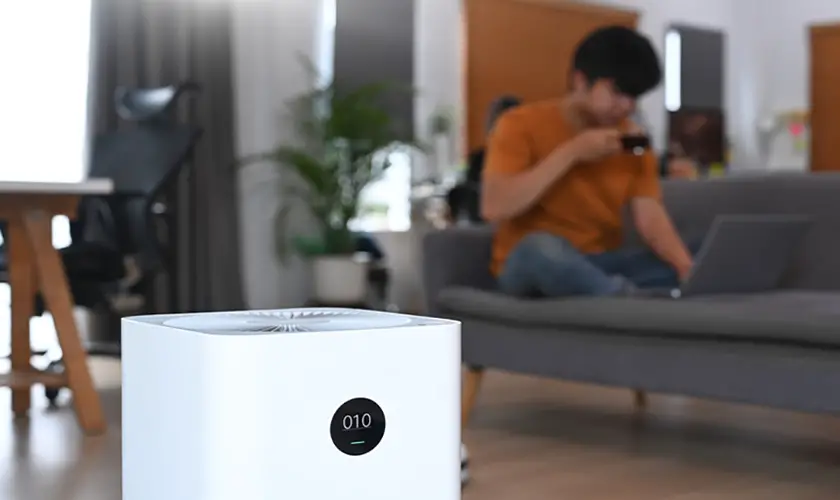
How Humidifiers & Dehumidifiers Help With Health Issues
Both systems aid in treating respiratory problems such as chest congestion, allergies, and asthma. A dehumidifier, for example, may help with asthma caused by damp air. Using a humidifier to loosen mucus in your nose due to a cold is also beneficial.
Humidifiers add moisture to the excessively dry air. Dry air can worsen allergies and asthma and make you more likely to get sick.
Humidifiers and dehumidifiers can help alleviate some common respiratory problems, including:
- Allergies and Sinus Infections: A humidifier can help you breathe better by reducing sinus inflammation, nasal congestion, and nosebleeds, all common problems for people with allergies. Dehumidifiers can help reduce moisture in the air, which helps eliminate allergens like dust mites and mold. 1
- Asthma: A humidifier can help people with asthma by moistening the air, making it harder for the airways to dry out and less likely for people to get an infection. A dehumidifier can reduce the air’s moisture levels, making breathing easier. It also keeps pollutants from staying in the air.
- Bronchitis: A humidifier can help reduce mold growth and bacteria, a common cause of bronchitis. A dehumidifier can also help minimize bronchitis symptoms, speeding up recovery.
- Common Cold: A humidifier can help mitigate cold symptoms such as sore throat, coughing, and wheezing.
- Dry Skin: A humidifier specifically helps with dry skin. Low humidity levels and dry air absorb moisture from your body, causing your skin to itch, crack, and even bleed.
- Influenza: A cool-mist humidifier can help relieve a stuffy nose and break up the mucus that causes chest congestion.
Humidifiers and dehumidifiers can also aid in maintaining a proper humidity level for babies and young children with allergies or asthma. Everyone may breathe a little more freely when humidity is within optimal levels.
How Does Humidity Affect Your Home?
How your house feels is another indication of the system you’ll require. You’ll need a humidifier if you have dry, itchy eyes, rough skin, and chapped lips.
If damp stains on the ceilings or walls exist or rooms are stuffy, you’ll need a dehumidifier. Mold can develop on wood beams, plaster, and leather furniture when too much moisture is in the air.
Some of the common problems a dehumidifier vs humidifier can help with include:
- Reduce or eliminate condensation on windows
- Reduce or eliminate mildew and mold growth on walls, ceilings, flooring, and furniture
- Lower high wood moisture content, which can cause wood decay and structural damage
- Reduce or eliminate cracking and peeling paint on walls and ceiling
- Prevent mold growth inside your HVAC system ductwork
- Reduces moisture that attracts wood-destroying organisms like termites, carpenter ants, and wood borer beetles
How Does Weather Affect Indoor Humidity?
The summer air is naturally more humid, making it stickier and unpleasant. The air in winter is dry and chilly. Heaters exacerbate the problem by removing most of the moisture from the home, leaving it dry.
Humidity is also a problem for pest control. Carpenter ants and termites, among other insects, are attracted to moisture.
Potted plants need more watering when the air is dry, but humid air makes them more susceptible to disease.
Portable humidifiers and dehumidifiers can help but require a lot of upkeep, and you may need several throughout your home.
Prioritize your comfort by installing a whole-home humidifier or dehumidifier as part of your home’s heating or cooling system. The unit automatically regulates the humidity level in your house depending on indoor and outdoor temperatures. This way, you can always be aware of the current humidity levels in your home and rest assured that it remains optimal.


